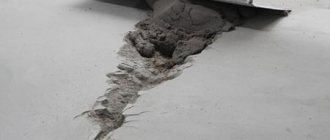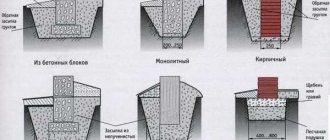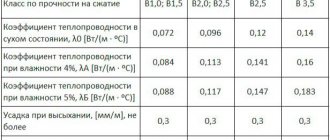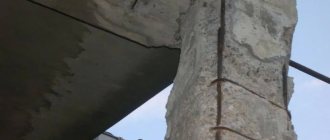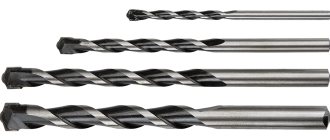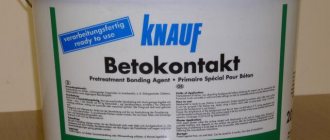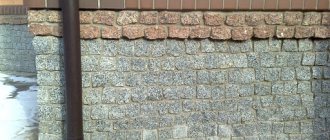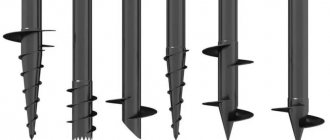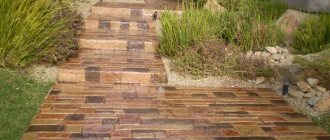Paint selection
When deciding on the final finish, it is decided what to paint the concrete on the street or inside the building. The operating conditions of the working surface are taken into account. Let's consider what you need to know about paintwork materials in order to make the right choice.
Basic criteria
Concrete is a universal building material. It is used to create almost all architectural elements of a building, decorative elements for recreation areas, pedestrian paths, and roadways. All of the above can be an object for painting.
Based on the variety of possible work sites, the selection criteria can be reduced to the following:
- inside or outside the building;
- changes in temperature and humidity;
- is there direct impact from natural precipitation or is there a canopy or enclosing structures;
- whether the object is subject to physical impact (friction, pressure, vibration);
- impact on humans or the environment.
In addition to the technical characteristics of the basic base of a particular paint, the properties of pigments are considered. These may be already added substances or individual colors.
Pigments for concrete paint Source prom.st
Resistance to fading is taken into account here. The decision regarding the level of gloss is also important. For example, irregularities are visible on a glossy surface, and a matte finish does not reflect light.
See also: Catalog of companies that specialize in paints and varnishes and related work
Types of paint
To understand how to paint a concrete path on the street or walls in a living room, you need to understand the properties of a specific type of paintwork material. The determining factor here is the base of a particular paint. When working with concrete, craftsmen use the following options:
- Acrylic. These are polymers and acrylic resin derivatives diluted in technical water. The degree of gloss here is influenced by the concentration of components. The resulting coating is resistant to moisture and temperature changes. However, the scope of application is limited due to short-term resistance to direct contact with water. That is, any premises can be painted, including unheated ones with high humidity. Complete drying of the two-layer coating occurs within 48 hours. On average, consumption is 400 g/sq.m, service life is 8-10 years.
Acrylic composition for painting floors Source lkmflot.ru
- Polyurethane. The object is ready for use in 2 weeks, but the surface film is formed in 2-3 days. Relatively inexpensive paint is used for facade work and painting surfaces inside the building. The main advantage here is its covering ability. This property is especially important for a workshop, parking lot or premises where they work with chemically active reagents. Consumption – about 400 g/sq.m, service life – up to 20 years.
- Rubber. The aqueous dispersion contains synthetic components based on acrylates. After drying, an elastic film is formed that maintains its integrity when the thermometer readings change. The paint is characterized by rapid hardening and a wide range of operating temperatures. The material dries within 20 minutes, including in slight frost. Operation is possible at -50-+60 degrees Celsius. The scope of application has virtually no restrictions. Consumption is 350 g/sq.m, service life is up to 10 years.
Rubber paint Source prom.st
- Epoxy. The two-component composition after two-layer painting of concrete forms a high-strength protective film. The coating dries in 12-24 hours. The base and hardener must be thoroughly mixed before use. Characteristic properties: resistance to direct exposure to water, chemical reagents in an acidic or alkaline environment, abrasion. The compositions are bright and do not fade over time. Consumption – 250 g/sq.m, service life is limited to 8 years.
In addition to the basic components, additives also influence the choice of what to paint concrete on the street or inside the house. The table shows the requirements for materials in relation to operating conditions.
| An object | Requirements | Dye |
| Ceiling and walls | Resistance to moisture, detergents, fading, environmental friendliness, hiding power. It is recommended to choose matte options to eliminate eye strain and visually hide unevenness. | For the residential sector, it is worth choosing acrylic, latex and acrylate compounds. The latter can be glazed or thick to create a textured coating. In public buildings, epoxy or polyurethane paint for concrete walls is considered the best. |
| Floor | Resistance to washing, physical and chemical influences is important here. | An acrylate composition is suitable for living rooms. Epoxy paint is recommended for use in buildings with moderate chemical exposure. The polyurethane variety of coatings is considered universal. There are options for internal use and specialized ones for external use. |
| Facade | In addition to resistance to changes in humidity and temperature, frost resistance, resistance to natural phenomena, elasticity, and vapor permeability are taken into account. | Silicone paint helps reduce the likelihood of efflorescence. Modified versions based on acrylic, silicone and acrylate are considered good solutions. They last a long time and cope better with natural phenomena. |
| Items outside the building | For paths or steps, high abrasion, resistance to changes in weather conditions, and deep penetration are taken into account. For structures in contact with water, water resistance is required. | Polyurethane and epoxy compounds can be used to paint outdoor concrete. For a fountain, it is better to choose rubber paint. |
The universal group of materials includes alkyd and oil enamels. However, craftsmen practically do not use them due to the short service life of the coating, fading in the sun, and low wear resistance. But there are advantages: budget cost, variety of ready-made color solutions, applicability for work inside and outside buildings.
Main types of paints for concrete
Paint for concrete on the street can be different, so you first need to pay attention to its characteristics and quality in order to complete the finishing competently and accurately. Consider also the purpose of the composition, since some types of dyes are recommended for use only indoors, while others are suitable for external finishing work. Solutions will differ in properties and wear resistance, which is why, if used incorrectly, there is a risk of rapid loss of quality of the result. Suitable paints for concrete coatings:
- Epoxy. This option is often used for painting floors at home. First you need to mix a solution consisting of two components. Additionally, it can be used to treat ceilings, due to its easy application and the formation of a durable coating after drying. One of the advantages of paint is water resistance. Because of this, it can be used in the bathroom or kitchen.
- Acrylic. It is used most often, but it is recommended to use it in several layers to create a dense texture. The main advantage of the dye is a large selection of colors and textures that can be used to decorate floors or walls. Acrylic paint for concrete can withstand temperature changes, moisture and mechanical stress, so it is often used for outdoor work.
- Polyurethane. The pigment is only suitable for painting floors, due to its complex texture. But when applied correctly it looks impressive and stylish. The result is not subject to mechanical stress or exposure to aggressive substances, which increases the adhesion of the composition to the surface.
- Water-based. Frost-resistant and wear-resistant paint for concrete for external use prevents damage to concrete by loads and caustic substances of alkaline agents. Suitable for application to almost any surface, even concrete, rubber, plastic.
Pay attention to: Painting plywood: choosing paint, preparing plywood and painting process
All dye options for concrete coatings have wear-resistant properties, since such a surface is usually processed outdoors. But first you should clarify the presence of some parameters so that the coloring result will remain in its original form longer. Keep in mind that concrete paints for exterior use have alternatives depending on the type of coating - glossy, matte, textured. Not all dyes have the same characteristics, but they will effectively decorate a wall, floors or ceiling outdoors.
Epoxy paint for concrete
Acrylic paint for concrete
Polyurethane paint for concrete
Technology
Painting an object involves performing mandatory and additional actions. The first is preparation of the base and finishing. The second includes dismantling, removing debris, working to protect adjacent structures from dust and contamination, limiting the work area with waterproof materials (adhesive tapes, tapes, films, stencils). Let's look at how to properly paint a concrete wall, floor, ceiling or exterior structure.
Preparing the base
Before painting concrete, it must be properly prepared. The base must be dry, clean, free of grease stains and free from rust or fungal growths. Since paintwork materials create a thin film, they are practically unable to fill pores and cracks. That is, you additionally need to remove dust from the surface and fill in all defects.
Upon closer examination, the following materials and means are used to solve the assigned problems (examples):
- cleaning of old paint - compositions with a high alkali content;
Mechanical removal of old coating Source yandex.net
- degreasing – 500 grams of soda ash with the addition of 10 liters of water;
- rust removal - removal with water and prevention with a solution of copper sulfate (15%);
- elimination of mold - impregnation with a destroyer followed by mechanical removal, washing with clean water, preventive treatment with a protective antiseptic for concrete (mineral surface);
- dust removal (before each stage of concrete preparation) - deep penetration primer, applied in at least 2 layers with intermediate drying.
To fill pores and cracks, plaster and putty are used, which are intended for working with mineral bases. If the surface is uniform and without defects, then you can immediately begin sanding. This will ensure smoothing, which will have a positive effect on the aesthetics of the paint coating. The grain size of the abrasive cloth can be equal to 80-100 units.
Sheets of sandpaper Source cloudinary.com
Coloring
Work is performed only on monoliths more than 30 days old after pouring. An exception is the use of dry pigment to tint a freshly poured walkway. Optimal conditions are considered to be temperatures above +10 degrees Celsius and relative air humidity in the range of 60-75%.
Concrete has low absorbency. Therefore, the application of the coloring composition must be impregnating in nature. The best way to solve the problem is with a roller. For the spray gun you need to use watery compounds. Spray the paint in 2-3 passes in a thin layer with intermediate drying within 12 hours.
Painting with a brush is also acceptable. Here you need to be prepared for the appearance of furrows from stubble. This is justified by the use of viscous paints. To visually smooth out the coating, you can paint the surface in 2-3 layers.
Briefly about the main thing
For coloring concrete, compositions are used that have the ability to penetrate deeply into a dense base.
Craftsmen prefer acrylic, rubber, polyurethane or epoxy paints.
The choice of materials depends on operating conditions: temperature, humidity, contact with water, mechanical stress.
An alternative to paints are powdered dyes (mineral and acidic dyes are in demand).
Ratings 0
Performance requirements for paint
Before choosing what to paint outdoor concrete with, you should consider the characteristics and properties of the compositions that you plan to use. This will ensure a positive outcome associated with high quality retention of the result. Check the compliance of several parameters of the dye:
- Water resistance. To use paint outside, it must not deteriorate under the influence of heat or water vapor;
- Adhesion. The composition must spontaneously penetrate into the surface structure, which will ensure its high adhesion. Additionally, you can pre-impregnate it with a primer;
- Wear resistance. When using concrete as a floor covering, the pigment must withstand constant physical stress;
- Resistant to fading. Due to constant exposure to ultraviolet radiation outdoors, the result should not fade when exposed to sunlight;
- Drying speed. Painting outdoors should always be done quickly to prevent dust build-up, air bubbles and other types of exposure to external factors.
Pay attention to: Cleaning clothes from acrylic paint: methods and means
Price is also an important but relative factor. Due to the large areas of the treated surface, the paint must have low consumption and price. Before painting, you can test the composition on a small area of concrete. This will allow you to check most parameters, preventing negative consequences after using the dye.
The paint must withstand constant physical activity and natural conditions
